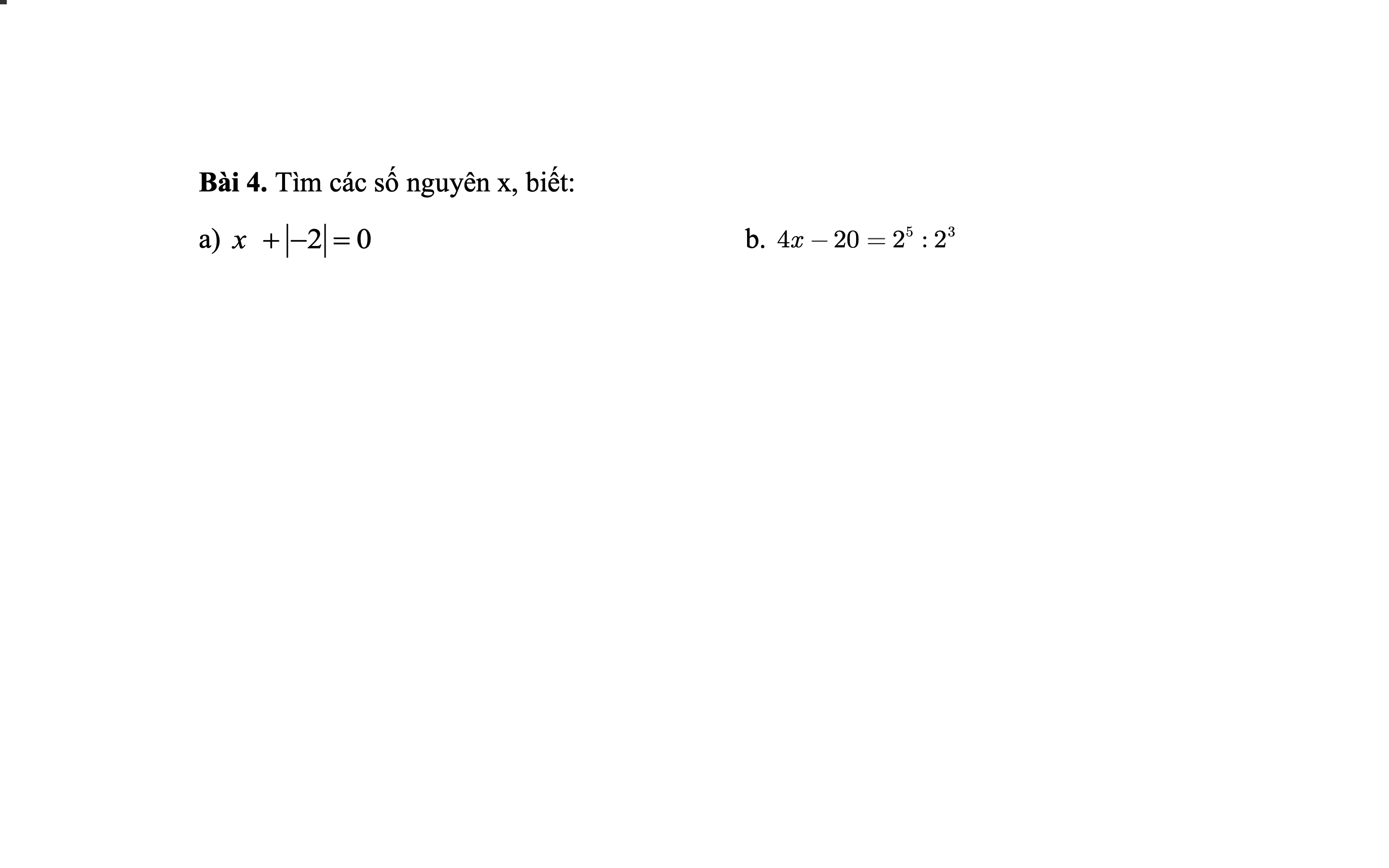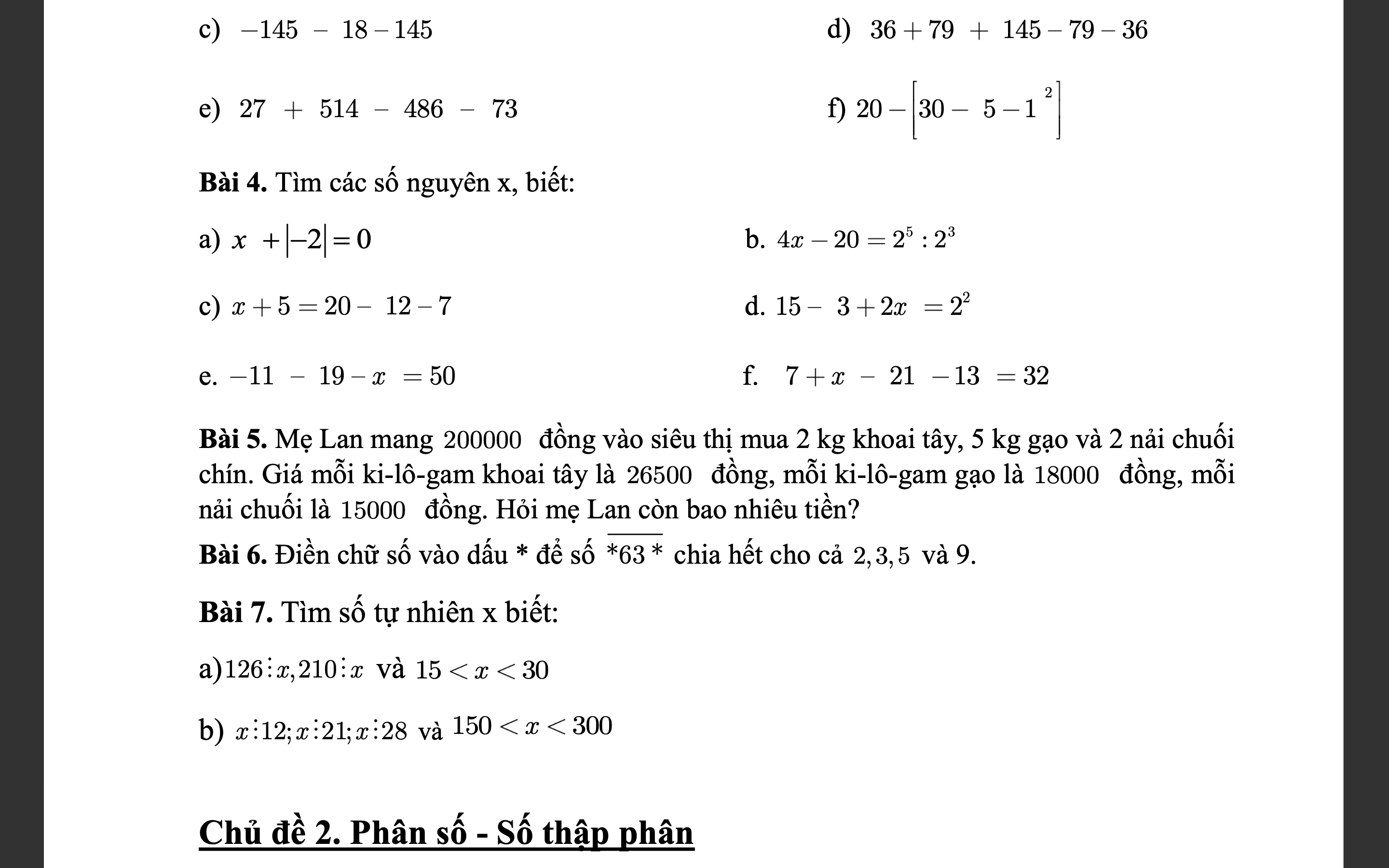25<52x-1<55
Hãy nhập câu hỏi của bạn vào đây, nếu là tài khoản VIP, bạn sẽ được ưu tiên trả lời.


\(\left(x-3\right)+\left(x-5\right)+\left(x-7\right)+...+\left(x-19\right)=3618\\ x-3+x-5+x-7+...+x-19=3618\\ 9x-\left(3+5+7+...+19\right)=3618\\ 9x-99=3618\\ 9x=3618+99\\ 9x=3717\\ x=3717:9\\ x=413\)
Vậy...

a: x+|-2|=0
=>x+2=0
=>x=-2
b: \(4x-20=2^5:2^3\)
=>\(4x-20=2^2=4\)
=>\(4x=20+4=24\)
=>\(x=\dfrac{24}{4}=6\)
a) x+|-2| = 0
⇒|x| = 0-(-2)
⇒|x| = 2⇒x= 2 hoặc x= -2
Vậy x = 2 hoặc x = -2 ϵ z
b) 4x - 20 = 25 : 23
⇒ 4x - 20 = 32 : 8
⇒ 4x - 20 = 4
⇒ 4x = 4+20
⇒4x = 24
⇒ x = 6
Vậy x = 6 ϵ z

Bài 5:
Tổng số tiền Lan phải trả khi mua đồ là:
\(2\cdot26500+5\cdot18000+2\cdot15000=173000\left(đ\right)\)
Số tiền mẹ Lan còn là:
\(200000-173000=27000\left(đ\right)\)
Bài 5:
Số tiền phải trả cho 2kg khoai tây là:
\(2\cdot26500=53000\left(đồng\right)\)
Số tiền phải trả cho 5kg gạo là:
\(5\cdot18000=90000\left(đồng\right)\)
Số tiền phải trả cho 2 nải chuối là:
\(2\cdot15000=30000\left(đồng\right)\)
Số tiền còn lại là:
200000-53000-90000-30000=27000(đồng)
Bài 6:
Đặt x=*
Đặt \(A=\overline{x63x}\)
A chia hết cho 5 và 2 nên x=0
=>\(A=\overline{0630}=630\)
Vì 630 chia hết cho cả 3 và 9
nên A=630 thỏa mãn yêu cầu đề bài
=>x=0
=>*=0
Bài 7:
a: \(126=2\cdot3^2\cdot7;210=2\cdot3\cdot5\cdot7\)
=>\(ƯCLN\left(126;210\right)=2\cdot3\cdot7=42\)
\(126⋮x;210⋮x\)
=>\(x\inƯC\left(126;210\right)\)
=>\(x\inƯ\left(42\right)\)
mà 15<x<30
nên x=21
b: \(12=2^2\cdot3;21=3\cdot7;28=2^2\cdot7\)
=>\(BCNN\left(12;21;28\right)=2^2\cdot3\cdot7=4\cdot3\cdot7=84\)
\(x⋮12;x⋮21;x⋮28\)
=>\(x\in B\left(84\right)\)
mà 150<x<300
nên \(x\in\left\{168;252\right\}\)

a; 285 + 470 + 115 + 230
= (285 + 115) + (470 + 230)
= 400 + 700
= 1100
b; 571 + 216 + 129 + 124
= (571 + 129) + (216 + 124)
= 700 + 340
= 1040

Tổng số lượt hành khách mà nhà ga số 1 và số 2 có thể tiếp nhận mỗi năm là:
6 526 300 + 3 514 500 = 10 040 800 (lượt)
Do tổng số khách cả ba nhà ga mà sân bay có thể tiếp nhận mỗi năm khoảng 22 851 200 lượt khách hàng nên
Số lượt hành khách mà nhà ga số 3 có thể tiếp nhận mỗi năm là:
22 851 200 - 10 040 800 = 12 810 400 (lượt)
Đ/s: 12 810 400 lượt khách
Đáp số: 12 810 400 lượt hành khách. à ga số 3 có thể tiếp nhận mỗi năm là:

Giải:
Số dân của Việt Nam trong năm 2020 là:
96 462 106 + 876 473 = 97 338 579 (người)
Kết luận: 97 338 579 (người)

9: \(A=\dfrac{\dfrac{1}{4}-5\cdot\left(\dfrac{3}{2}\right)^2}{10\dfrac{5}{9}+\left(-\dfrac{2}{3}\right)^2}=\dfrac{\dfrac{1}{4}-5\cdot\dfrac{9}{4}}{10+\dfrac{5}{9}+\dfrac{4}{9}}\)
\(=\dfrac{\dfrac{1}{4}-\dfrac{45}{4}}{10+1}=\dfrac{-44}{4}:11=-\dfrac{44}{44}=-1\)
\(B=\dfrac{5}{12}\cdot3,7-\dfrac{5}{12}\cdot6,7=\dfrac{5}{12}\cdot\left(3,7-6,7\right)\)
\(=\dfrac{5}{12}\cdot\left(-3\right)=-\dfrac{5}{4}\)
\(A-B=\left(-1\right)-\left(-\dfrac{5}{4}\right)=-1+\dfrac{5}{4}=\dfrac{1}{4}\)
10: \(P=\left(6,8;1,36-\dfrac{29}{3}:\dfrac{58}{9}\right):\dfrac{0.27^3}{0.09^3\cdot2}\)
\(=\left(5-\dfrac{29}{3}\cdot\dfrac{9}{58}\right):\dfrac{\left(0,3\right)^6\cdot3^3}{0,3^6\cdot2}\)
\(=\left(5-\dfrac{3}{2}\right):\dfrac{3^3}{2}=\dfrac{7}{2}\cdot\dfrac{2}{27}=\dfrac{7}{27}\)
\(P+\dfrac{1}{27}=\dfrac{7}{27}+\dfrac{1}{27}=\dfrac{8}{27}=\left(\dfrac{2}{3}\right)^3\)
=>\(P+\dfrac{1}{27}\) là bình phương của một số hữu tỉ

9: \(A=\dfrac{\dfrac{1}{4}-5\cdot\left(\dfrac{3}{2}\right)^2}{10\dfrac{5}{9}+\left(-\dfrac{2}{3}\right)^2}=\dfrac{\dfrac{1}{4}-5\cdot\dfrac{9}{4}}{10+\dfrac{5}{9}+\dfrac{4}{9}}\)
\(=\dfrac{\dfrac{1}{4}-\dfrac{45}{4}}{10+1}=\dfrac{-44}{4}:11=-\dfrac{44}{44}=-1\)
\(B=\dfrac{5}{12}\cdot3,7-\dfrac{5}{12}\cdot6,7=\dfrac{5}{12}\cdot\left(3,7-6,7\right)\)
\(=\dfrac{5}{12}\cdot\left(-3\right)=-\dfrac{5}{4}\)
\(A-B=\left(-1\right)-\left(-\dfrac{5}{4}\right)=-1+\dfrac{5}{4}=\dfrac{1}{4}\)
10: \(P=\left(6,8;1,36-\dfrac{29}{3}:\dfrac{58}{9}\right):\dfrac{0.27^3}{0.09^3\cdot2}\)
\(=\left(5-\dfrac{29}{3}\cdot\dfrac{9}{58}\right):\dfrac{\left(0,3\right)^6\cdot3^3}{0,3^6\cdot2}\)
\(=\left(5-\dfrac{3}{2}\right):\dfrac{3^3}{2}=\dfrac{7}{2}\cdot\dfrac{2}{27}=\dfrac{7}{27}\)
\(P+\dfrac{1}{27}=\dfrac{7}{27}+\dfrac{1}{27}=\dfrac{8}{27}=\left(\dfrac{2}{3}\right)^3\)
=>\(P+\dfrac{1}{27}\) là bình phương của một số hữu tỉ

9: \(A=\dfrac{\dfrac{1}{4}-5\cdot\left(\dfrac{3}{2}\right)^2}{10\dfrac{5}{9}+\left(-\dfrac{2}{3}\right)^2}=\dfrac{\dfrac{1}{4}-5\cdot\dfrac{9}{4}}{10+\dfrac{5}{9}+\dfrac{4}{9}}\)
\(=\dfrac{\dfrac{1}{4}-\dfrac{45}{4}}{10+1}=\dfrac{-44}{4}:11=-\dfrac{44}{44}=-1\)
\(B=\dfrac{5}{12}\cdot3,7-\dfrac{5}{12}\cdot6,7=\dfrac{5}{12}\cdot\left(3,7-6,7\right)\)
\(=\dfrac{5}{12}\cdot\left(-3\right)=-\dfrac{5}{4}\)
\(A-B=\left(-1\right)-\left(-\dfrac{5}{4}\right)=-1+\dfrac{5}{4}=\dfrac{1}{4}\)
10: \(P=\left(6,8;1,36-\dfrac{29}{3}:\dfrac{58}{9}\right):\dfrac{0.27^3}{0.09^3\cdot2}\)
\(=\left(5-\dfrac{29}{3}\cdot\dfrac{9}{58}\right):\dfrac{\left(0,3\right)^6\cdot3^3}{0,3^6\cdot2}\)
\(=\left(5-\dfrac{3}{2}\right):\dfrac{3^3}{2}=\dfrac{7}{2}\cdot\dfrac{2}{27}=\dfrac{7}{27}\)
\(P+\dfrac{1}{27}=\dfrac{7}{27}+\dfrac{1}{27}=\dfrac{8}{27}=\left(\dfrac{2}{3}\right)^3\)
=>\(P+\dfrac{1}{27}\) là bình phương của một số hữu tỉ



\(25< 5^{2x-1}< 5^5\)
\(5^2< 5^{2x-1}< 5^5\)
\(2< 2x-1< 5\)
\(2+1< 2x< 5+1\)
\(3< 2x< 6\)
\(\dfrac{3}{2}< x< 3\)
x=2